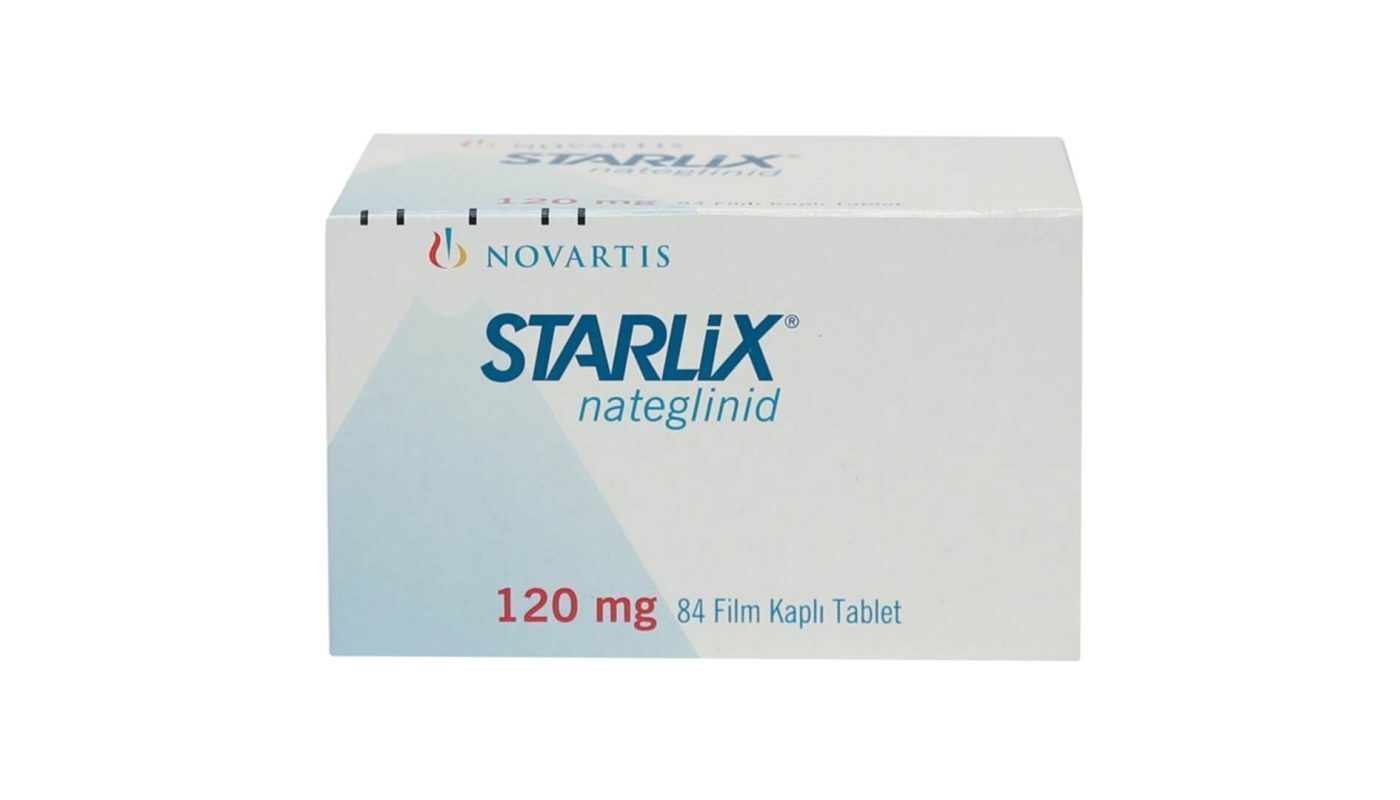Starlix (Nateglinide)

Dosages
Starlix 120 mg
| Quantity | Price per pill | Total price | |
|---|---|---|---|
| 30 | $1.33 | $40.00 | |
| 60 | $1.12 | $67.00 | |
| 90 | $1.04 | $94.00 | |
| 120 | $1.00 | $120.00 | |
| 180 | $0.96 | $173.00 | |
| 270 | $0.90 | $243.00 | |
| 360 | $0.80 | $288.00 |
Payment & Shipping
Your order is securely packed and usually ships within 24 hours. Below is what a standard package looks like.
It is about the size of a regular letter (9.4x4.3x0.3 inches) and shows no details about what is inside.



| Shipping Method | Estimated delivery |
|---|---|
| Express Free for orders over $300.00 | Estimated delivery to the U.S.: 4-7 days |
| Standard Free for orders over $200.00 | Estimated delivery to the U.S.: 14-21 days |









Discount Coupons
- Independence Day - July 4, 2025 10% JULY410
- Labor Day - September 1, 2025 7% LABOR07
- Thanksgiving - November 27, 2025 9% THANKS09
Brand Names
| Country | Brand Names |
|---|---|
 Argentina Argentina | Nateglin |
 Czechia Czechia | Trazec |
 Japan Japan | Starsis |
 Netherlands Netherlands | Trazec |
 Portugal Portugal | Trazec |
| Manufacturer | Brand Names |
|---|---|
| Glenmark Pharmaceuticals Ltd. | Glinate |
FAQ
Description
Patients with type 2 (non-insulin-dependent) diabetes take Starlix to help lower their blood sugar levels. It is recommended in conjunction with exercise and diet. It is an antidiabetic medication. Starlix decreases blood glucose levels. Your doctor may prescribe Metformin and Starlix to be taken together or separately.
Managing elevated blood sugar levels can also prevent illnesses, including impotence, kidney disease, heart disease, blindness, strokes, and circulation issues.

Warning Information
Do not take it if you suffer from diabetic ketoacidosis, you have type 1 diabetes, or you are allergic to any ingredient in Starlix.
Notify your doctor if any of the following apply to you:
Allergies to certain foods, medications, or other substances; high fever or malnourishment; pregnancy, nursing, or intending to become pregnant; use of any over-the-counter or prescription medications; dietary supplements; herbal preparations; issues with the pituitary, kidney, liver, or adrenal glands.
You might have dizziness. Certain substances or alcohol may make this problem worse. Try to avoid drinking alcohol as it might exacerbate the adverse effects of drugs.
Follow the diet and fitness regimen that your medical assistant has recommended.
Do not forget always to have an identification card that details your diabetes.
Remember to monitor your blood sugar levels.
One possible cause of low blood sugar could be Starlix. During treatment, your body may feel weak, faint, exhausted, nervous, or perspiring. In addition, the medication could cause headaches, tremors, chills, altered vision, and an increase in appetite. If you have low blood sugar, carry glucose (tablets or gel) to correct it quickly. You can also quickly consume some foods and beverages, such as honey, table sugar, orange juice, candies, and regular soda. Let your medical assistant know if it occurs.
Before getting medical or dental care, let your medical assistant or dentist know you plan to use this remedy.
Starlix's efficacy and safety in children are unknown; before giving it to a child, have them consult a physician.
Take this medication only when it is absolutely necessary while nursing or pregnant.
Interactions
Inform your physician about all medications, both prescription and over-the-counter, that you take, particularly the following:
Corticosteroids (e.g., prednisone), thyroid drugs (e.g., levothyroxine), "blood thinners" (e.g., warfarin), other diabetes drugs (e.g., glyburide, rosiglitazone, tolbutamide), NSAIDs (e.g., ibuprofen, naproxen), sympathomimetic drugs (e.g., adrenaline-like drugs, pseudoephedrine), MAO inhibitors (e.g., furazolidone, linezolid, phenelzine, selegiline, tranylcypromine), some "water pills" (e.g., thiazide diuretics, hydrochlorothiazide), aspirin-like drugs (salicylates), and beta-blockers (e.g.propranolol).
Never begin or cease taking any medicine without a doctor's prescription. This list of interactions may be incomplete. Give your doctor a complete list of all your medications, herbal remedies, nutritional supplements, and over-the-counter medications. Additionally, let them know whether you smoke, take illegal substances, or drink alcohol. Certain things might interfere with your medication.
How Should I Use This Medication?
Note: Don't give this medication to anyone else. Please take it as prescribed by your doctor, neither more nor less.
Take the medication orally 15 to 30 minutes before meals. See your physician for further information in-depth.
What Happens If I Forget to Take the Dose?
Try to take the dose as soon as you remember if you miss it. Take just one dose if it's time for your next one. The dosage doesn't need to be doubled.
Excessive Dosage
Any medication used in excess might have a negative impact on your health. Get in touch with your healthcare provider right away if you suspect an overdose.
When used in excess, this medication may result in the following side effects: sweating, increased appetite, fatigue, change in ability to see, loss of consciousness, seizures, headache, anxiety, and unsteadiness.
Which Adverse Effects of this Medication Should I Know About?
The most frequent adverse effects are fatigue and lightheadedness, headaches, joint pain, visual abnormalities, heightened appetite, tremors, upper respiratory infection, symptoms of the flu (chills, sore throat, fever), elevated heart rate, sweating, and anxiety.
Low blood sugar can cause symptoms like sweating, shakiness, hunger, and a fast heartbeat. Notify your doctor right away if any of these happen.
Serious side effects include stomach discomfort, fever, allergies resulting in skin rashes, lips, tongue, and face swelling, hives, itching, breathing difficulties, and yellowing of the skin or eyes.
Other negative effects could occur; this is not an exhaustive list. Tell your doctors about all the side effects you encounter.
How to Store
Starlix needs to be kept in a firmly closed container at room temperature. It should be kept out of light, heat, and moisture, away from sinks and bathrooms, away from animals, and out of children's reach.
You should speak with your doctor before using the medication. This page does not aim to cover all precautions, including safety measures, medication interactions, side effects, usage, recommendations, or allergic reactions.




















